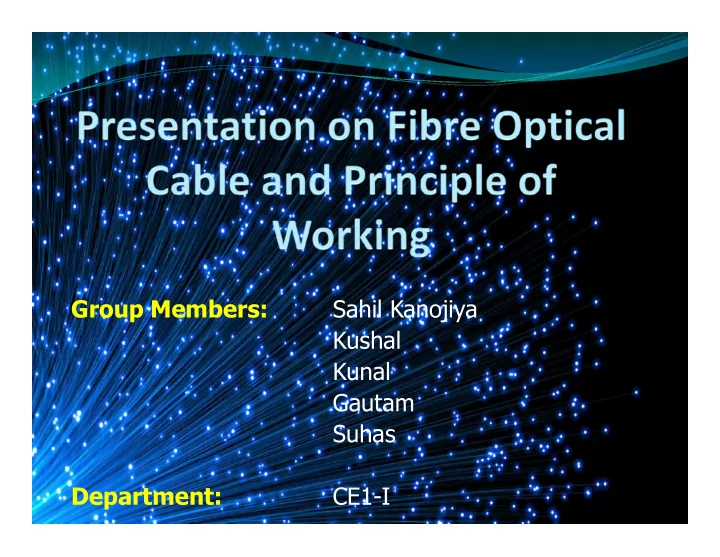

Group Members: Sahil Kanojiya Kushal Kunal Gautam Suhas Department: CE1-I
INDEX Introduction to optical Fibers Working Principle Structure of Optical Fiber Cable Structure of Optical Fiber Cable Advantage / Disadvantage of optical fiber Application of optical fiber Conclusion
What is Optical Fiber? An optical fiber is a hair thin cylindrical fiber of glass or any transparent dielectric medium. The fiber which are used for optical communication are wave guides made of transparent dielectrics. Its function is to guide visible and infrared light over long distance
Structure of Optical FiberCable Core - central tube of very thin size made up of optically transparent dielectric medium and carries the light form transmitter to receiver. The core diameter can vary from about 5um-100 um. Cladding - outer optical material surrounding the core having reflecting index lower than core. It helps to keep the light within the core throughout the phenomena of total internal reflection. Buffer Coating - plastic coating that protects the fiber made of silicon rubber. The typical diameter of fiber after coating is 250-300um.
Working Principle Total Internal Reflection(TIR) n sin n sin 1 1 2 2 Optical fibers work on the principle of total internal reflection With light, the refractive index is listed The angle of refraction at the interface between two media is governed by Snell’s law
Working of Optical Fiber
Optical fiber is classified into two categories based on:- 1) The number of modes- Single mode fiber(SMF) and Multi-mode fiber(MMF) Multi-mode fiber(MMF) 2) The reflective index- Step index optical fiber Graded- index optical fiber
Advantages and Disadvantages Advantages Disadvantages Immense bandwidth to System installation is very utilize costly. Total electrical isolation in Total electrical isolation in Only point-to-point Only point-to-point the transmission medium communication is possible. Very low transmission loss Precise and costly instruments would be Small size and light weight required. High signal security Splicing is time consuming. Very low power consumption It accept only unipolar codes and wide scope of system expansion etc.
Applications of Optical Fiber Cable telecommunication field Civil, consumer and industrial application industrial application military applications Broadband applications decorations Medical Industry (endoscopy and surgeries)
At the last, we have successfully studied about optical fiber, working principle of Optical Fiber i.e. Total Internal Reflection and gone through various applications of optical Fiber in medicine, Military and various other research and Fiber in medicine, Military and various other research and industrial applications. ⁂ THANK YOU ⁂
Recommend
More recommend